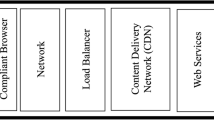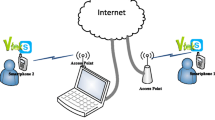Abstract
In recent years, there has been a substantial increase in the distribution of videos over the Internet, and this has become one of the major activities that attract extensive attention. This means that users expect to watch videos of the highest quality. Quality of experience (QoE) describes the degree of satisfaction or annoyance of a user when they are using a multimedia service or application. Meeting users’ expectations requires understanding the factors that influence QoE and efficiently managing resources to optimize video quality. The current objective approaches that assess QoE mostly rely on the analysis of video traffic. However, recent research has demonstrated that this approach cannot sufficiently evaluate perceived QoE and that multiple factors, including media technical features, influence QoE. It is crucial for service providers to identify the effects of social context, in addition to those of user-related, content-related, and system factors, on perceived QoE of the end user. Recent studies have focused on understanding the characteristics of user behavior and engagement, as well as the effect of these factors on QoE. In this study, we use social context factors and user engagement as subjective factors to structure a user QoE evaluation model. First, we study social context factors and user engagement characteristics and investigate their correlation with QoE. Next, we build a metric that estimates the end-to-end QoE for a specific aspect of user actions. Then, by simulating mathematical metrics, we employ machine learning models to predict QoE; finally, we validate this approach using metrics for statistical evaluation of quality prediction models.







Similar content being viewed by others
References
Cisco Visual Networking Index (VNI) Forecast. (2016). https://www.cisco.com/c/en/us/solutions/service-provider/visual-networking-index-vni/index.html.
Zhu, Y., Heynderickx, I., & Redi, J. A. (2015). Understanding the role of social context and user factors in video quality of experience. Computers in Human Behavior, 49, 412–426.
Murphy, S., Searles, M., Rambeau, C. & Murphy, L. (2004). Evaluating the impact of network performance on video streaming quality for categorised video content. In Proceedings of IEEE packet video, Irvine (CA), USA (pp. 221–225).
Rix, A. W., Beerends, J. G., Hollier, M. P., & Hekstra, A. P. (2001). Perceptual evaluation of speech quality (PESQ)—A new method for speech quality assessment of telephone networks and codecs. In IEEE international conference on acoustics, speech, and signal processing. Proceedings (Cat. No. 01CH37221) (Vol. 2, pp. 749–752). IEEE.
Williams, N., Zander, S., & Armitage, G. (2006). A preliminary performance comparison of five machine learning algorithms for practical IP traffic flow classification. ACM SIGCOMM Computer Communication Review, 36(5), 5–16.
Chatzopoulou, G., Sheng, C., & Faloutsos, M. (2010). A first step towards understanding popularity in YouTube. In INFOCOM IEEE conference on computer communications workshops (pp. 1–6). IEEE.
ITU-R Recommendation BT.500-11. (2002). Methodology for the subjective assessment of the quality of television pictures.
Yu, H., Xie, L., & Sanner, S. (2015). The lifecyle of a youtube video: Phases, content and popularity. In Ninth international AAAI conference on web and social media.
Paasch, C., Ferlin, S., Alay, O., & Bonaventure, O. (2014). Experimental evaluation of multipath TCP schedulers. In Proceedings of the 2014 ACM SIGCOMM workshop on capacity sharing workshop (pp. 27–32). ACM.
VQEG Report. (2004). RRNR-TV Group Test Plan, Draft Version 1.7. [Online]. Available: http://www-ext.crc.ca/vqeg/frames.html.
Hoßfeld, T., Schatz, R., Seufert, M., Hirth, M., Zinner, T., & Tran-Gia, P. (2011). Quantification of YouTube QoE via Crowdsourcing. In MQoE.
Hoßfeld, T., Egger, S., Schatz, R., Fiedler, M., Masuch, K., & Lorentzen, C. (2012). Initial delay versus interruptions: Between the devil and the deep blue sea. In QoMEX.
Joskowicz, J., & Carlos López Ardao, J. (2011). Combining the effects of frame rate, bit rate, display size and video content in a parametric video quality model. In Proceedings of the 6th Latin America networking conference (pp. 4–11). ACM.
Aggarwal, V., Halepovic, E., Pang, J., Venkataraman, S., & Yan, H. (2014). Prometheus: Toward quality-of-experience estimation for mobile apps from passive network measurements. In HotMobile.
Joumblatt, D., Chandrashekar, J., Kveton, B., Taft, N., & Teixeira, R. (2013). Predicting user dissatisfaction with internet application performance at end-hosts. In 2013 Proceedings IEEE INFOCOM.
Chen, K. T., Tu, C. C., & Xiao, W. C. (2009). Oneclick: A framework for measuring network quality of experience. In IEEE INFOCOM.
Seufert, M., Zeidler, B., Wamser, F., Karagkioules, T., Tsilimantos, D., Loh, F., & Valentin, S. (2018). A wrapper for automatic measurements with YouTube’s native Android app. In 2018 Network traffic measurement and analysis conference (TMA) (pp. 1–8). IEEE.
Letaifa, A. B. (2017). Adaptive QoE monitoring architecture in SDN networks: Video streaming services case. In 13th International wireless communications and mobile computing conference (IWCMC) (pp. 1383–1388). IEEE.
Letaifa, A. B. (2018). Real time ML-based QoE adaptive approach in SDN context for HTTP video services. Wireless Personal Communications, 103(3), 2633–2656.
Abar, T., Letaifa, A. B., & El Asmi, S. (2017). Machine learning based QoE prediction in SDN networks. In 13th International wireless communications and mobile computing conference (IWCMC) (pp. 1395–1400). IEEE.
Lehmann, J., Lalmas, M., Yom-Tov, E., & Dupret, G. (2012). Models of user engagement. In International conference on user modeling, adaptation, and personalization (pp. 164–175). Berlin: Springer.
Krumme, C., Cebrian, M., Pickard, G., & Pentland, S. (2012). Quantifying social influence in an online cultural market. PloS ONE, 7(5), e33785.
Stoddard, G. (2015). Popularity dynamics and intrinsic quality in reddit and hacker news. In Ninth international AAAI conference on web and social media.
Shamma, D. A., Yew, J., Kennedy, L., & Churchill, E. F. (2011). Viral actions: Predicting video view counts using synchronous sharing behaviors. In Fifth international AAAI conference on weblogs and social media.
YouTube. (2012). YouTube now: Why we focus on watch time. http://youtubecreator.blogspot.com/2012/08/youtube-now-why-we-focus-on-watch-time.html.
Yi, X., Hong, L., Zhong, E., Liu, N. N. & Rajan, S. (2014). Beyond clicks: dwell time for personalization. In Proceedings of the 8th ACM conference on recommender systems (pp. 113–120). ACM.
Dobrian, F., Sekar, V., Awan, A., Stoica, I., Joseph, D., Ganjam, A. & Zhang, H. (2011). Understanding the impact of video quality on user engagement. In ACM SIGCOMM computer communication review (Vol. 41, No. 4, pp. 362–373). ACM.
Wassermann, S., Wehner, N., & Casas, P. (2019). Machine learning models for YouTube QoE and user engagement prediction in smartphones. ACM SIGMETRICS Performance Evaluation Review, 46(3), 155–158.
Yang, M., Wang, S., Calheiros, R. N., & Yang, F. (2018). Survey on QoE assessment approach for network service. IEEE Access, 6, 48374–48390.
Li, C. T., Shan, M. K., Jheng, S. H., & Chou, K. C. (2016). Exploiting concept drift to predict popularity of social multimedia in microblogs. Information Sciences, 339, 310–331.
Shafiq, M. Z., Erman, J., & Ji, L., et al. (2014). Understanding the impact of network dynamics on mobile video user engagement. In ACM international conference on measurement and modeling of computer systems (pp. 367–379). ACM.
Brunnström, K., Beker, S. A., De Moor, K., Dooms, A., Egger, S., Garcia, M. N., & Lawlor, B. (2013). Qualinet white paper on definitions of quality of experience.
Park, M., Naaman, M., & Berger, J. (2016). A data-driven study of view duration on youtube. In Tenth international AAAI conference on web and social media.
ITU-T P.1401. (2012). Methods, metrics, and procedures for statistical evaluation, qualification and comparison of objective quality prediction models, Geneva.
Author information
Authors and Affiliations
Corresponding author
Additional information
Publisher's Note
Springer Nature remains neutral with regard to jurisdictional claims in published maps and institutional affiliations.
Rights and permissions
About this article
Cite this article
Laiche, F., Ben Letaifa, A., Elloumi, I. et al. When Machine Learning Algorithms Meet User Engagement Parameters to Predict Video QoE. Wireless Pers Commun 116, 2723–2741 (2021). https://doi.org/10.1007/s11277-020-07818-w
Published:
Issue Date:
DOI: https://doi.org/10.1007/s11277-020-07818-w




